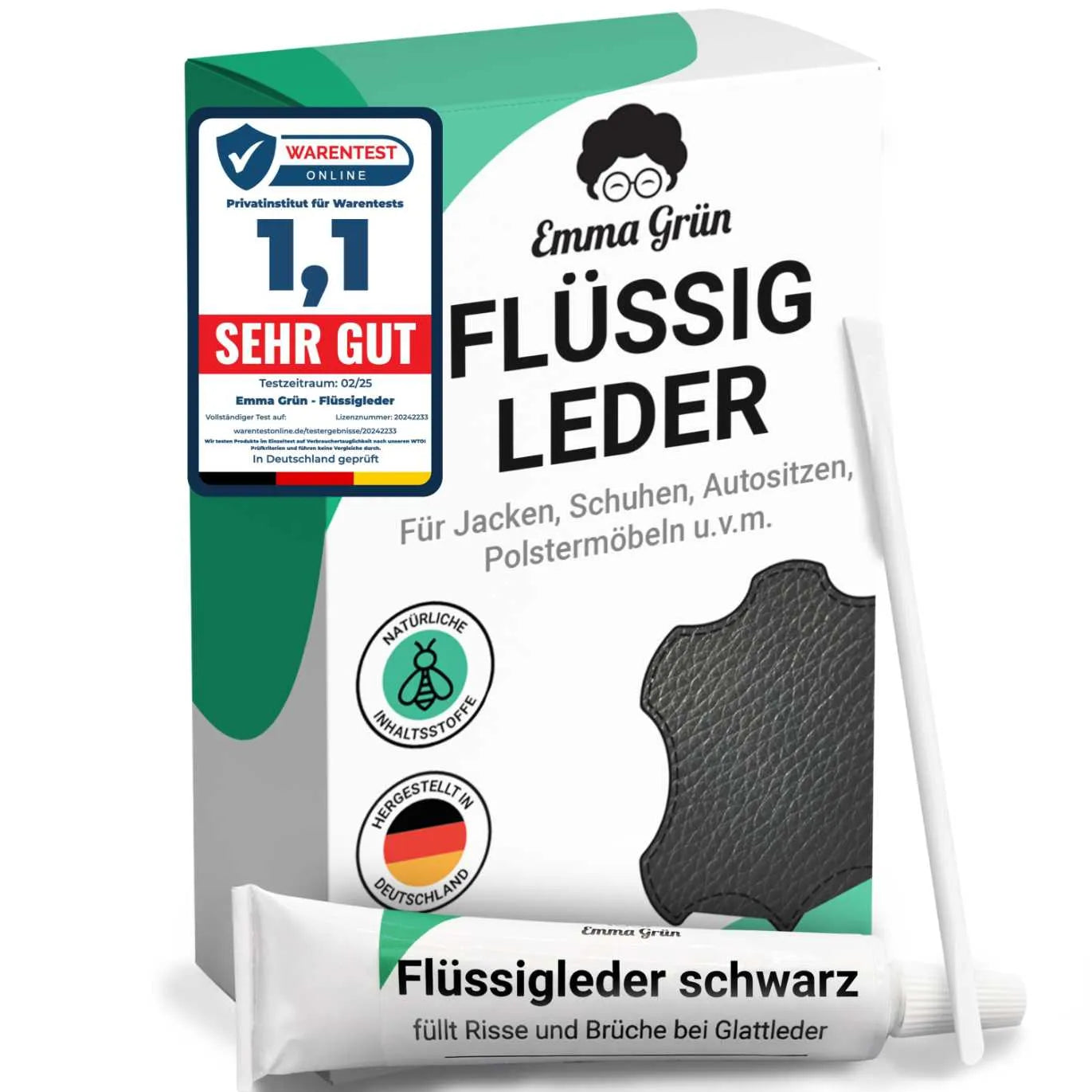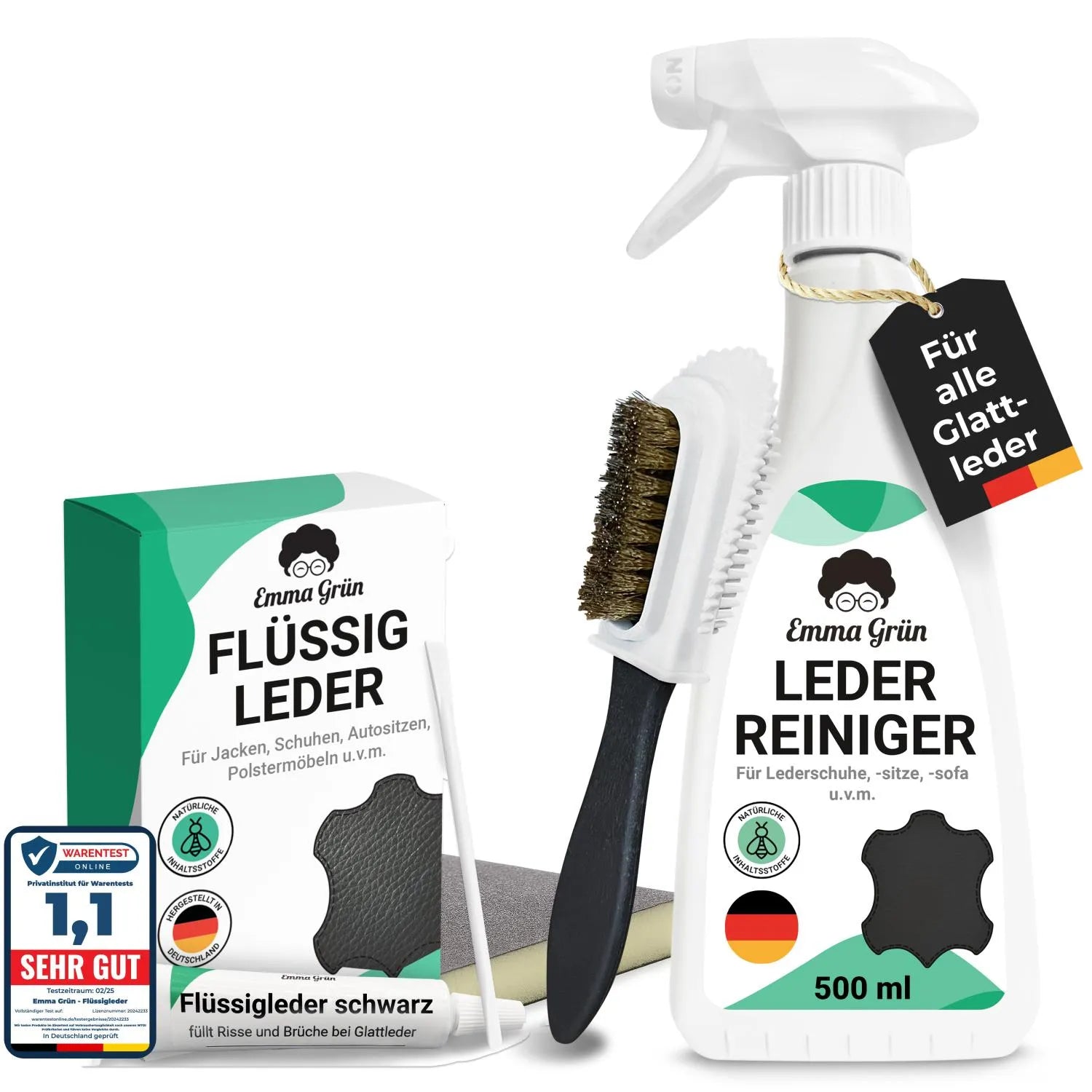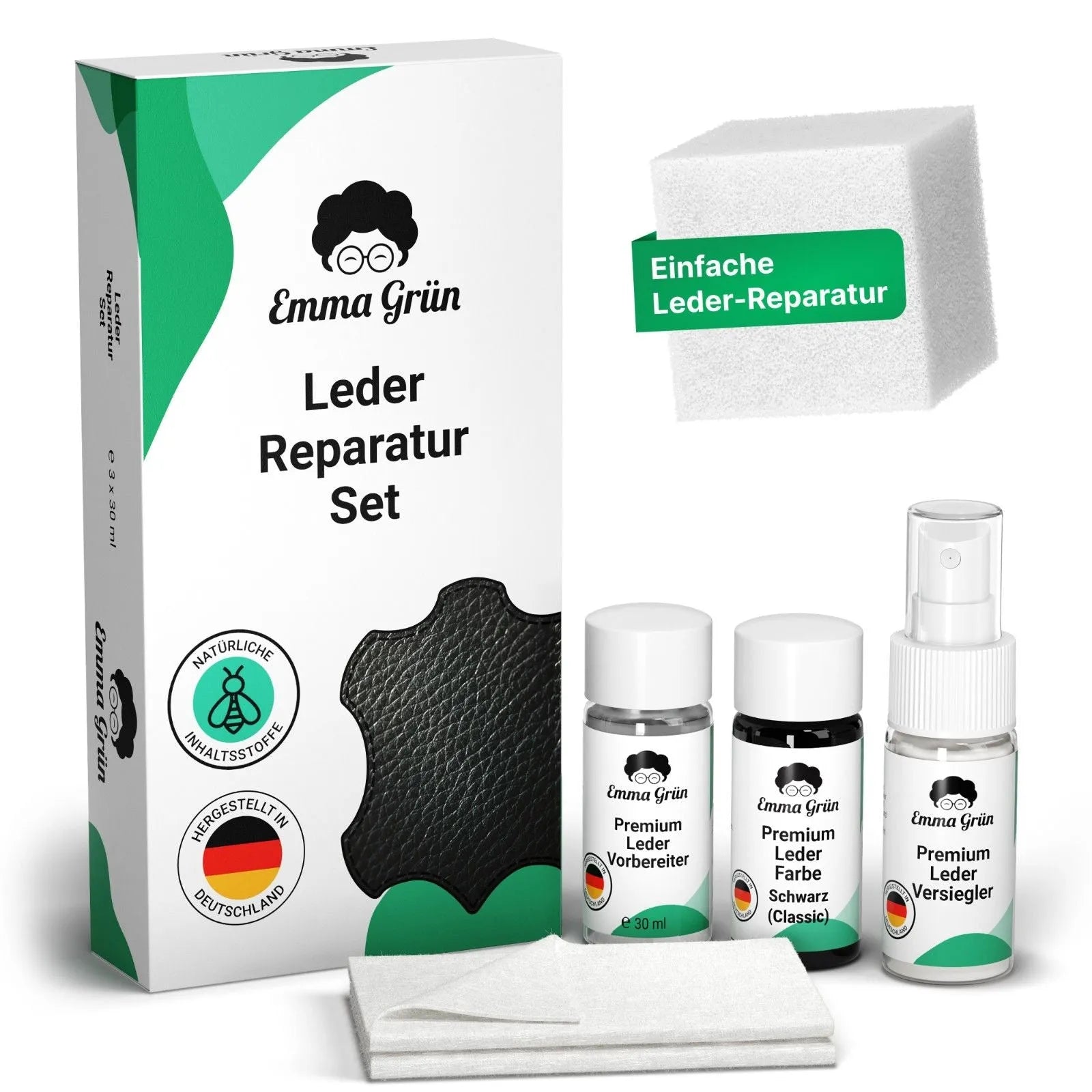Natural leather is a durable and stylish material, but over time it can show signs of wear in the form of abrasions. Small cracks and holes can also become visible on leather due to one or two accidents, external influences or inadequate care.
If you love your leather clothes, you shouldn't miss out on the following tips. In the following guide, you will learn how to repair your leather jacket, what to look out for after the repair and how to identify and prevent moth holes.
Common damage to leather clothing: The causes
Natural leather is a robust material that can still be susceptible to certain types of damage. Damaged seams, as well as cracks and scratches on leather, can occur for a variety of reasons . To prevent this type of damage, it is important to know the causes . Only then will you be able to take the right measures to protect your favorite leather items.
Causes of damaged seams in leather
- Normal wear and tear: Frequent use will cause wear and tear at the seams over time, especially in areas subject to heavy wear.
- Material fatigue: The yarn used for the seams can lose elasticity over time and become brittle, leading to cracks.
- Poor quality of workmanship: Poor sewing material or poorly processed seams can tear or come apart more easily.
- Improper storage: Leather items stored in damp, very dry or sun-exposed locations may suffer damage to the seams.
- Mechanical damage: Strong tension or pressure on the seams, for example due to overstretching, can lead to damage.
Causes of cracks and scratches on leather
- Drying out: Leather that is not regularly moisturized can dry out and crack.
- Mechanical impact: Scratches are often caused by mechanical impacts such as sharp objects, pet claws or rough surfaces.
- Sunlight: Long-term exposure to direct UV light can weaken the leather and cause cracking.
- Chemical damage: Using unsuitable cleaning or care products can damage the leather and cause cracks.
- Improper handling: Severe bending or stretching of the leather, especially if it is brittle, can lead to cracks.
But it is not always the factors mentioned that can cause tears and holes in leather clothing. Clothes moths can also make themselves comfortable in your wardrobe and cause damage to your leather clothing. If their presence is discovered too late, it can be very annoying.
Even though the tiny moth larvae generally prefer textiles made of wool, they can sometimes attack your leather clothing . This is because materials of animal origin are high on their food list. This is why they don't turn down real leather either. But what do moth holes look like?
Moth holes in leather: How to detect them
Moth holes are a lesser-known but serious threat to leather clothing. Although moths typically prefer textiles like wool, they can also damage thin or poorly cared for leather . Here are some signs you can look for moth holes:
- Small, irregular holes: Unlike tears or cuts caused by wear and tear, moth holes often have an asymmetrical shape.
- Congregation in certain areas: Moths tend to settle in less visible areas such as seams or folds, where holes are more likely to occur.
- Other signs of infestation: In addition to holes, you can look for moth larvae, cocoons or fine web material near the damaged areas.
If you have been able to identify the material pests in your wardrobe based on the damage, you should take action against their presence as quickly as possible . At the same time, however, it is just as important to take measures to prevent further contamination .
Clothes moths: How to prevent an infestation
There is nothing more annoying than having your favorite leather jacket ruined by small holes due to a pest infestation. To avoid moth damage to your leather clothing, we have some effective tips for you:
- Regular care: Keep your leather items clean and give them regular care. Moths are more likely to be attracted to dirty or oily materials.
- Proper storage: Store leather clothing in well-ventilated, dry closets. Use breathable garment bags for extra protection.

- Natural moth repellents: Lavender sachets or cedar wood blocks in your closet can effectively repel moths. If the scent loses intensity over time, you can refresh the sachets or cedar wood blocks with a natural essential oil . We recommend the essential oils from Emma Grün.
- Regular inspection: Check your leather items regularly for signs of moth infestation, especially if you have not worn them for a long time.
By following these simple steps, you can not only prevent moth holes, but also maintain the overall quality and appearance of your leather clothing . If your favorite leather jacket is already marred by moth holes, you don't have to throw it away. There are a few methods you can use to repair your leather jacket.
Leather jacket repair: step-by-step instructions
Whether it's a small tear, abrasions or moth holes, you can save your leather jacket with the help of the following instructions. Here's how to do it:
Treating scratches on smooth leather
- Cleaning the affected area: Use a clean, soft cloth and a mild leather cleaner to gently clean the area around the scratch. Then allow the leather to dry completely.
- For light scratches: Gently rub the scratch with a leather conditioner or leather balm. These products can help fill small scratches and nourish the leather.
- For deeper scratches: Use a special leather repair kit. We recommend the leather repair kits from Emma Grün . Depending on the color you want, you can choose between white, black or neutral liquid leather. Each kit contains a tube of leather repair gel, which is applied to the scratch to conceal it, as well as a spatula with which the product can be applied optimally to the repair area . Follow the instructions on the packaging exactly. Then nothing can go wrong.
- Aftercare: After the product has dried, polish the treated area with a clean, soft cloth. If you have worked a little imprecisely or applied too much gel, you can carefully work on the filled area with a sanding pad.
- Leather care after repair: To keep the leather supple and protect it from future damage, we recommend that you then apply a leather care cream or leather care emulsion.
Emma Green Tip : Regular use of natural leather care products helps make your leather more resistant to scratches and wear.
[product:liquidleather]
Repair all your smooth and synthetic leather
- 🛡️ Strong repair
- ✔️ Various colors
- ✔️ Always works
Directly to the product
Repairing holes and tears in smooth leather
- Apply liquid leather: Emma Grün's liquid leather is also perfect for repairing small holes or tears . Carefully apply the gel, smooth it with the spatula provided and let it air dry according to the instructions on the packaging.
- Fine sanding: To smooth transitions, a fine sanding process may be necessary after drying.
- Color refreshment and care: If necessary, a suitable leather color can be applied to improve the appearance. Treat the jacket regularly with a leather care product to keep the material supple.
The mentioned procedure also works if you want to repair your leather sofa or leather pants. However, for extensive damage, we recommend that you seek the professional help of an expert. Choose a specialized leather workshop for professional repair. They can restore the leather seamlessly and ensure the original quality.
Caring for smooth leather after repair with liquid leather: What you need to pay attention to
After repairing smooth leather with liquid leather , careful care is crucial to protect the leather and maintain its natural appearance. The following care tips will help you protect your leather clothing from further damage after the repair:
- Wait for complete drying: After application, allow the liquid leather to dry completely. Follow the drying times indicated on the product.
- Gentle cleaning: After the liquid leather has dried, gently clean the surface with a soft, slightly damp cloth to remove any dust or dirt.
- Apply leather care products: Apply a high-quality care product. Choose a product that is specifically designed for smooth leather . This helps to keep the leather supple and prevents it from drying out and cracking. Use the care product sparingly and work it into the material in circular movements.
- Regular care treatment: To keep your leather in optimal condition, you cannot avoid regular care. Treatments at intervals of at least 3 months are recommended.
- Protection from environmental influences: Protect the natural material from direct sunlight and extreme temperatures , as these can bleach and damage the leather.

- Avoiding moisture: Protect natural leather from excessive moisture. If the leather gets wet, dry it slowly in the air and avoid direct heat sources .
- Leather impregnation: Consider whether leather impregnation makes sense to protect the material from water and stains. Choose an impregnation that is suitable for smooth leather.
Emma Green Tip: Before applying a new product to the entire surface, test it on a small, hidden area to make sure there are no negative reactions. After a repair, be especially careful when polishing the leather so as not to damage the repair area. By regularly and correctly caring for repaired smooth leather, you can ensure that it looks good and maintains its quality for a long time.
Repairing suede with liquid leather: is it possible?
Suede can also be repaired with liquid leather. However, there are a few things to consider when doing this. Suede, known for its velvety surface and sensitive texture, reacts differently to repairs than smooth leather . Here's what you need to pay attention to:
- Color Match: It is crucial that the liquid leather matches the suede exactly in color. Since suede often has a very specific color and texture, it may be difficult to find a perfect match.
- Careful application: Due to the sensitive surface, liquid leather should be applied to the suede very carefully and in thin layers.
- Aftercare: After repairing with liquid leather, the treated area may look slightly different from the rest of the suede. To adjust the texture again, we recommend brushing it with a suede brush.
- Testing: It is always advisable to test the product on a small, inconspicuous area first to ensure that there are no adverse reactions.

In case of major damage or uncertainty, it is advisable to contact a professional who has experience in repairing suede.
Conclusion: Leather repair with liquid leather
Repairing leather with liquid leather is a practical way to repair minor damage such as tears or scuffs. When applied to smooth leather, liquid leather usually produces good results by filling the damaged area and matching the color.
However, care must be taken with suede as its velvety texture is challenging. Colour matching is particularly important and the product must be carefully applied in thin layers. After treatment, light finishing may be necessary to restore the suede to its original appearance.
Generally, it is advisable to test liquid leather on an inconspicuous area first and seek professional advice in case of major damage. Overall, the use of liquid leather is an effective solution to extend the life of leather goods while supporting the principles of sustainability.
FAQ: Questions & Answers
Can liquid leather be used on all types of leather?
Liquid leather is best suited for smooth leather. Care should be taken with suede and other delicate leathers as the repair may alter the texture and appearance of the leather.
How do I choose the right color of liquid leather?
The choice of colour is crucial to ensure that the repaired area is not noticeable. It is advisable to choose a colour that is as close as possible to the original tone of the leather.
Can I use liquid leather for larger damages?
Liquid leather is mainly intended for minor repairs. For larger damages, it is often better to consult a specialist.
Do I need to take special care of the leather after the repair?
After repair, leather should be cared for as usual. It can be helpful to clean the natural material and treat it with a suitable leather care product to maintain its appearance and suppleness.
Is the use of liquid leather sustainable?
The use of liquid leather can be considered a sustainable practice as it helps to extend the lifespan of leather products and thus reduces the need for new purchases. This is in line with principles of waste reduction and resource conservation.
Sources
- https://www.helpster.de/lederjacke-reparieren-so-beseitigen-sie-loecher_120422
- https://www.lederzentrum.de/tip/moebel/fluessigleder.html
- https://www.frag-team-clean.de/diy/leder-reparieren.html
- https://picard-fashion.com/blogs/lederkunde/leder-reparieren
- https://picard-fashion.com/blogs/lederkunde/kratzer-auf-leder-entfernen





